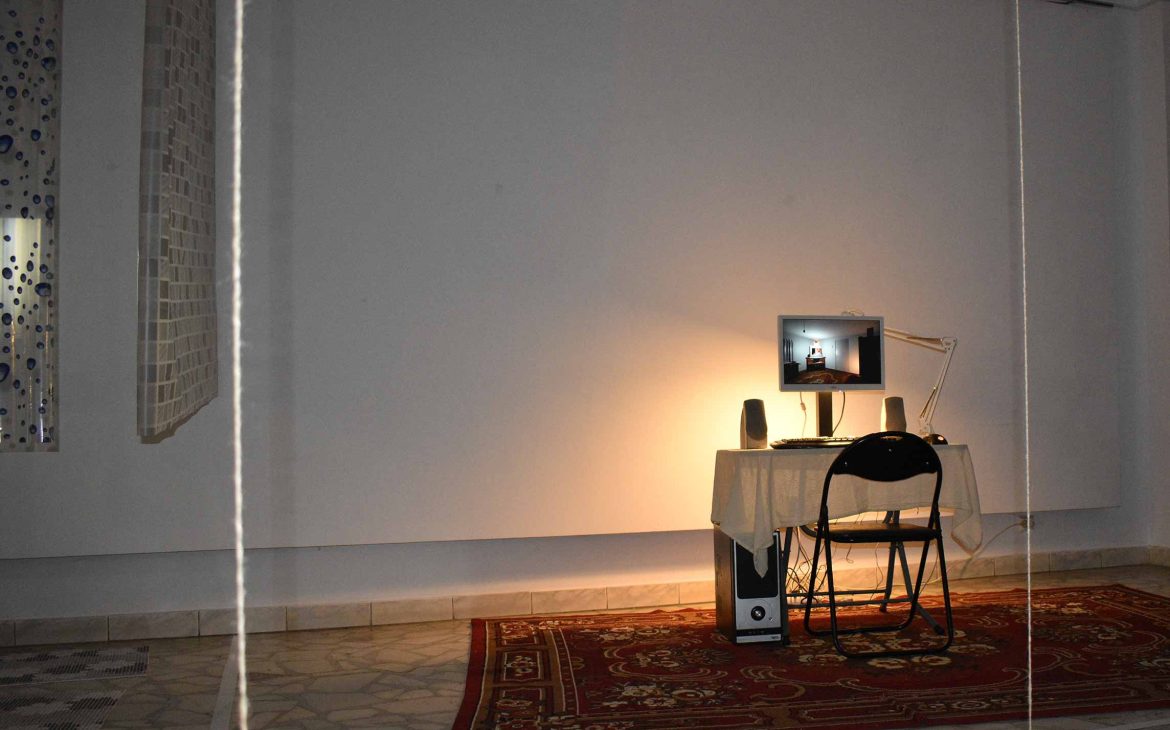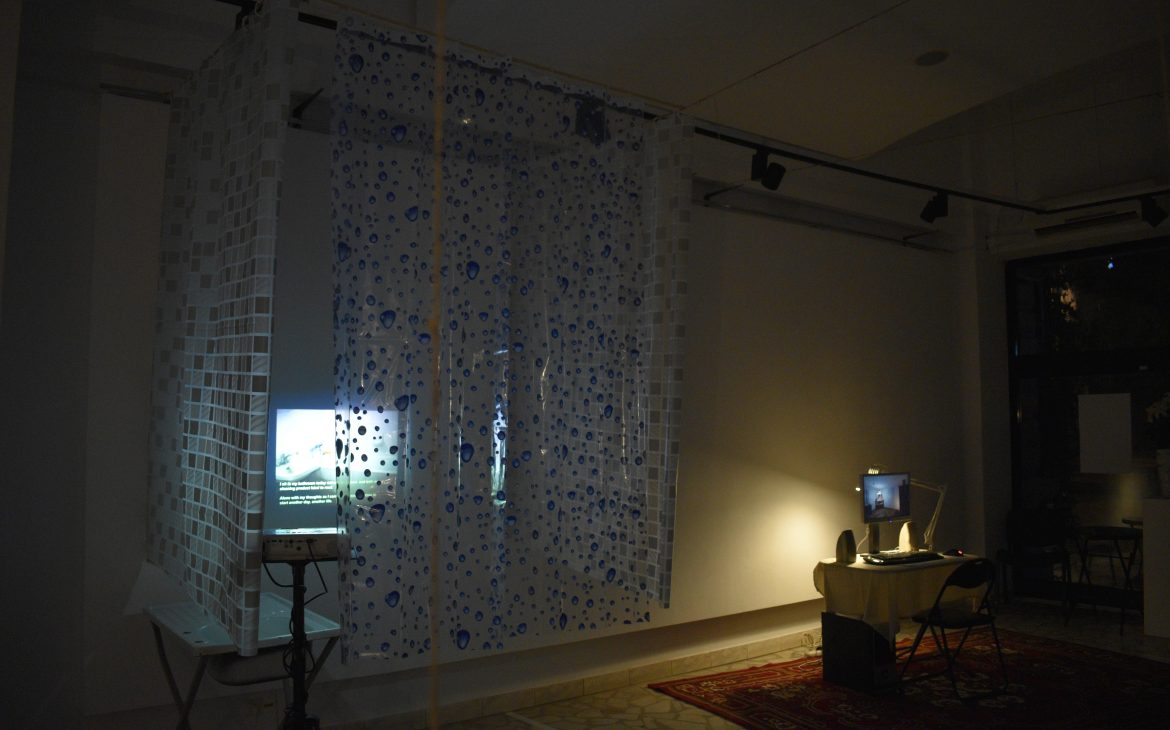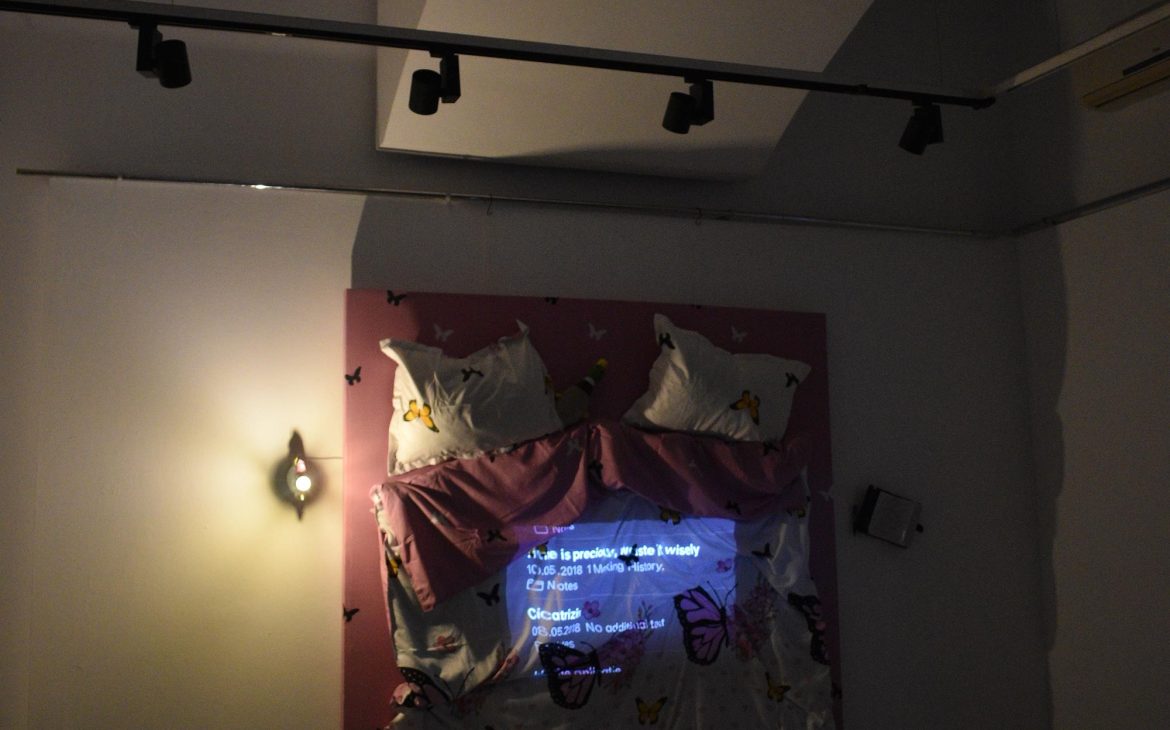Author: Gabriela Filip, a student at the Faculty of Art History and Theory (Second Year)
In an unusual form, the “Nicolae Tonitza” Art Gallery in Iași presented, between October 3-8, 2024, the space of an apartment under the title “Etaju’ 1/ Floor 1”, the result of the joint creative effort of the “Apartment no. 6” artistic group, which also includes the curator of the exhibition, Cristiana Ursache.1
Following the example of the artist Tracey Emin—who exhibited her bed and with it the linen with traces of existence—and of Joseph Kosuth—who exhibited the chair in a physical, linguistic, and photographic format—the artistic group “Apartment 6” reconstructs a typical apartment with a bathroom, living room, bedroom, kitchen, and speaker.
From one perspective, the exhibition “Etaju 1” emphasizes affective memory and how it influences our relationship with the spaces in which we live. The installations suggest each room and carry with them a specific personal narrative, thus becoming a shared space of memory and a singular artistic expression.

The artists of “Apartment No. 6” transform fragments of domestic life into visual poetry, evoking events, emotions, and the atmosphere of past times through a mixture of technology, fun, and reinterpreted everyday objects.
Thus, the pre-2000s bedroom, designed by Marean2, is an installation that focuses on the media memory of that period. The space includes a desk with a chair. On the desk, there is a computer that reproduces the image of the artist’s childhood room, capturing details such as the stove, the carpet with “The Abduction from the Serai”, the television and the programs specific to those years; these two punctuating the specificity of taste of the era. The public has access to “visit” every corner of the room, thus entering the privacy of Marean’s room, and can even change the TV programs, precisely to the content of shows from the 90s.
The bathroom designed by Radu Mihai Tanasă3 is a delimitation made of shower curtains, with a sink and a screen running a video sequence illustrating a bathtub with an animated character – an imaginary friend from childhood. Once again, the affective memory is invoked, one in which the bathroom is not only a functional space but a place of imagination and dreaming. Here, the imaginary universe from childhood is brought back to the present, suggesting how physical spaces, loaded with subjective memories, can transform into fantastic worlds.

Ioana Mihai4 took care of a bedroom, which is another reinterpretation of privacy. The sheet, pillows, and duvet are attached vertically to the wall, over which is projected the image of the diary and the notes from the artist’s adolescence, as they were recorded on her phone. The work talks about the transformation of privacy in the digital age – the bed is no longer just a physical refuge but also a virtual one, mediated by technology that did not yet expose privacy. Light projections, both digital and real, merge and evoke our increasingly complex interaction with the surrounding space, where virtual lights become an extension of the physical world.
Artist Pansy’s5 intervention brings a playful element inspired by YuGiOh/Duel Masters. On one wall, a playing card is framed, and in the large black box next to it, the drawing on the book is graphically reproduced on a very large scale by the artist herself and can be seen through a small window on the wall of the box, similar to a slide. This gesture of resizing a childhood object speaks to how nostalgia and playfulness are part of our identity, even in adulthood. Extracting such an element from its original context and amplifying it turns it into an object of contemplation and becomes an aesthetic element, a window into our own childhood.

The work of Ruxandra Mărgineanu6 suggests a speaker made of hanging bottles and photographs, reminding her of her grandfather and the ritual of making traditional alcohol. By also referring to the preservation activities of vegetables and fruits, this work is a tribute to tradition and intergenerational relations. The objects used, mute by their nature, represent encapsulations of memory—the hanging bottles are not only containers but also symbols of the emotional relationship between granddaughter and grandfather, of the time spent together, and of everyday gestures loaded with meanings.
Curator Cristiana Ursache states, “The exhibited works speak of the multiple dimensions of intimacy and invite a reconsideration of our relationship with familiar spaces. Thus, the audience is prompted to reflect on their own living space experience and explore how these spaces bear witness to the most profound acts of human existence.”
So, the lamp on the desk is no longer just a source of light but symbolizes the moments spent in solitude, studying, or reading. All the objects that occupy the living space silently preserve the traces of touch, routine, and emotions and reveal how the domestic space, although deeply intimate, contains elements that resonate with the feelings and experiences of others.
From another perspective, the domestic place changes into a public place open to the spectator who goes through the conversion of the tenant, keeping in both poses the intrusive aura of the guest.
In the fluctuating distribution of roles, a subtle tension emerges between being at home in a gallery and being a spectator in one’s own space. The guest-spectator can simultaneously feel at home through the experience evoked by the exhibited objects, perhaps similar to personal ones but also foreign, aware of the fact that he is exploring someone else’s world.
The shift in perspective disintegrates traditional relationships between host and guest, tenant and spectator, generating a transgressive and challenging experience. Emotionally, the installation complex can also be perceived as a comment on “feeling at home” anywhere, including in the gallery, versus “feeling a stranger at home,” where one sometimes assumes the role of guest, stranger, or spectator.
By analogy with the meaning of place and urban space given by the French philosopher Michel de Certeau, the private place – the object of the exhibition “Floor 1” – becomes a space practiced through the activities and perceptions of the public. And from this perspective, the apartment becomes an unstable place, a web of ever-changing meanings, resulting in a reconfiguration of the relationship between private and public, between ordered space and practiced space, ultimately challenging attachments to comfort provided by fixed places and fixed identities.
The viewer is not there to follow rules of everyday use but to explore, interpret, and reconfigure the meanings associated with domestic space. Through this interaction, the apartment becomes a space of negotiation and reinterpretation, just as, for Michel de Certeau, passers-by turn an orderly street into an active urban space.
Similar to how Michel de Certeau talks about detournement – that is, the use of urban spaces for unexpected purposes – and in the case of the exhibition apartment, the domestic space is hijacked and transformed. The chair at the office table is no longer just a place to sit but a symbol of privacy offered for exploration, thus losing its original privacy; the box, which is normally a place of domestic and private activities, turns into a work of art, a space of aesthetic reflection and questioning what a private space really means.
Notes:
- Cristiana Ursache is a curator at Artep Iași Gallery, researcher and editor. Her curatorial practice focuses on documenting and understanding collaborating artists and facilitating the visual experience for different audiences. Experienced in cultural mediation, supports dialogue and exchange of knowledge on the occasion of any cultural project. Currently, she is working on doctoral research on curatorial practices in Romania from 2000-2023, contributing to the mapping and evolution of Romanian curatorship;
- Marean is a Romanian multimedia artist. Much of his artistic output explores but is not limited to, themes ranging from internet culture to the various dimensions of violence, neglect and degradation. Mostly, the nature of his artistic work is presented through a raw, reckless and experimental approach, the artistic statement taking shape through bold images that participate in the creation of a strange, abstract and undefined space;
- Radu-Mihai Tănasă is an emerging artist whose artistic practice deals with themes such as cultural dysphoria, male-Balkan identity and the emigrant condition. He works predominantly with video, performance and software art;
- Ioana Mihai is an emerging visual artist who works in Bucharest, Romania. She develops themes with social and cultural dimensions to raise awareness of the concerns of the community in which it operates. To express her speech, she approaches multidisciplinary techniques, which combine painting, sculpture or installations;
- Pansy is a multimedia artist from Iasi, Romania. Interested in the visual aesthetics of Romania in the 2000s. Pansy refuses both the registration in classic categories of visual art and the assumption of a transparent artistic discourse. By assuming a deliberately opaque artistic positioning, Pansy preferred the artist’s discourse communicated through his works. Pansy investigates the possibilities of her chosen medium and is always centered on her practice, and by combining the large themes of historical painting with contemporary forms, Pansy’s works are not only about their specific subject matter but also about the act of painting itself;
- Ruxandra Mărgineanu’s personal experience plays a central role in her artistic journey. She tries to develop subjects both from memories and through an observational process, drawing on the culture and appearance of Romania during and after the communist regime.




